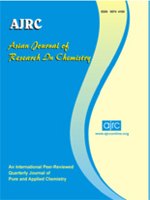Separation evaluation of selected organophosphorus fungicides by NP-TLC and RP-HPTLC
Subscribe/Renew Journal
Poisoning by organophosphorus fungicides (OPFs) is although uncommon; recently, a few cases of deaths owing to the ingestion of OPFs were reported. Literatures on chromatographic separation of these fungicides are minimal. The evaluation of the efficacies of separation is of primary interest when it is contemplated from a forensic matrix. Hence, a study was undertaken to evaluate the efficacies of separation of three OPFs, namely ditalimfos D, edifenfos E, and tolclofos-methyl TM by NP-TLC on silica gel 60F254 and RP- HPTLC on silica gel 60RP-18 WF254. The relationship between the mobile phase composition (n-hexane-acetone for NP-TLC, and methanol-water for RPHPTLC) and RF values affirmed that with the increase in the acetone content in case of NP-TLC and decrease of the water content in RP-HPTLC resulted in the increase in RF values for the three OPFs. The three OPFs are completely separated from each other with RF0.04, except for the pair of compounds E-D in NP-TLC with mobile phase composition 10:0, and for the pair of compounds E-TM in case of RP-HPTLC with mobile phase compositions of 10:0, 7:3, 6.5:3.5 and 6:4. Under the chromatographic conditions used, D and TM were found to have higher RM values in normal phase and reverse phase, respectively. Ditalimfos was therefore adsorbed strongly in NP-TLC and tolclofosmethyl in RP-HPTLC. The peak resolution (RS) values in NP-TLC were greater than 1.5 for the pair of compounds ED, TM-E, and TM-D in solvent composition ratio of 9:1, 8.5:1.5, 8:2, and 7.5:2.5. RS values in RP-HPTLC were also higher for all the pair compounds, except for E-TM. The study revealed that the system of NP-TLC with mobile phase n-hexane-acetone (9:1) provided the optimum conditions for the separation of D, E, and TM as compared to RPHPTLC system. Complete separation of E from TM was not achieved in RP-HPTLC.
Keywords
NP-TLC, RP-HPTLC, Mobile Phase Composition, Peak Resolution
Subscription
Login to verify subscription
User
Font Size
Information



